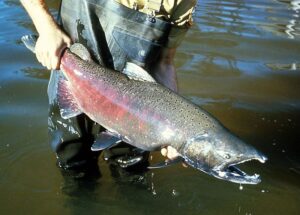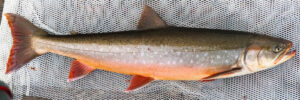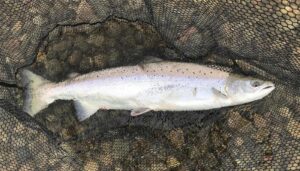Fish is an essential part of a balanced diet, and when it comes to nutrient-rich seafood, Arctic char, and salmon are often top contenders. Both fish are lauded for their rich flavors, impressive nutritional profiles, and versatile cooking options. But how do they compare in terms of taste, health benefits, and culinary uses? In this article, we’ll take an in-depth look at the differences and similarities between Arctic char and salmon to help you decide which fish best fits your needs.
Introduction to Arctic Char and Salmon
Before diving into the detailed comparison, it’s important to get familiar with both species.
- Arctic Char: A cold-water fish native to alpine lakes and Arctic coastal waters, Arctic char belongs to the Salmonidae family, the same family as salmon and trout. Its habitat, primarily in northern regions like Alaska, Canada, and Scandinavia, gives it a unique flavor profile that sits somewhere between trout and salmon.
- Salmon: Salmon is arguably one of the most popular fish varieties consumed worldwide. Found in both Atlantic and Pacific oceans, salmon is known for its firm, fatty flesh, and rich taste. The species can be farmed or caught wild, and various types of salmon, such as King, Sockeye, and Atlantic, each offer subtle differences in flavor and texture.
Appearance and Texture

When comparing Arctic char and salmon, their visual differences are immediately apparent.
- Arctic Char: The skin of Arctic char typically ranges from a silvery hue with spots to a darker, grayish-green shade, depending on the region where it’s caught. The flesh color can range from pink to deep red, similar to salmon, but the texture is more delicate and tender. Arctic char tends to have a fine flake, making it an appealing option for those who prefer a slightly lighter texture in their fish.
- Salmon: Salmon flesh varies from light pink to a vivid red-orange, depending on the species and whether the fish was wild or farmed. Wild-caught salmon, like Sockeye, generally has a deeper red hue than farmed salmon. The texture is firmer and meatier than Arctic char, and the flesh holds up well to grilling, searing, or poaching.
Taste Profile

The flavor is a primary consideration when choosing between Arctic char and salmon, and though both are from the same family, they offer distinct tastes.
- Arctic Char: Arctic char has a milder, slightly sweet flavor than salmon. It strikes a balance between the richness of salmon and the subtlety of trout. This makes it ideal for people who enjoy fish but prefer a less overpowering taste. Its clean, delicate flavor pairs well with light seasoning, herbs, and sauces.
- Salmon: Salmon is known for its bold, rich, and sometimes slightly oily taste, particularly in varieties like King or Atlantic salmon. Wild-caught salmon typically has a more pronounced flavor than farmed. Its fattiness lends itself well to robust seasonings, such as smoked paprika, soy-based marinades, or spicy rubs, making it a favorite for grilling and baking.
Nutritional Benefits
Both Arctic char and salmon are packed with essential nutrients, but some key differences might influence your choice based on dietary preferences.
Arctic Char:

- Omega-3 Fatty Acids: Arctic char is a great source of omega-3 fatty acids, though slightly lower than salmon. These healthy fats support heart health, reduce inflammation, and promote brain function.
- Protein: Like most fish, Arctic char is rich in protein, providing a lean source of high-quality, easily digestible protein.
- Calories: Arctic char tends to have slightly fewer calories per serving compared to salmon, making it a good choice for those on a lower-calorie diet.
- Vitamins and Minerals: Arctic char is a rich source of vitamins D and B12, as well as important minerals like selenium, which has antioxidant properties.
Salmon:

- Omega-3 Fatty Acids: Salmon is one of the richest sources of omega-3s, especially wild varieties. Omega-3s are crucial for heart health, reducing cholesterol levels, and supporting overall well-being.
- Protein: Salmon is packed with protein, with about 22–25 grams per 3.5-ounce serving. This makes it an excellent choice for muscle repair and overall body maintenance.
- Calories: Salmon, particularly fattier varieties like King salmon, tend to have more calories than Arctic char due to its higher fat content. However, these calories come primarily from healthy fats.
- Vitamins and Minerals: Salmon is a powerhouse of nutrients, boasting high levels of vitamins D, B12, and B6. It is also rich in selenium, magnesium, and phosphorus.
Environmental Impact and Sustainability
Sustainability has become a significant factor in seafood consumption, and both Arctic char and salmon have differing environmental impacts depending on how they’re sourced.
- Arctic Char: Arctic char is often considered a sustainable choice because much of it is farm-raised in eco-friendly conditions. Arctic char farms typically have lower environmental impacts compared to salmon farms, as they don’t use as many chemicals and antibiotics, and the fish are raised in less crowded conditions. Wild Arctic char, when available, is also sustainably harvested in many regions.
- Salmon: The sustainability of salmon depends heavily on whether it’s wild-caught or farmed. Wild salmon, particularly from well-managed fisheries in Alaska, is considered a sustainable option. However, farmed salmon has raised some environmental concerns, such as water pollution, antibiotic use, and fish welfare. The sustainability of farmed salmon can vary significantly by location and farming practices.
Culinary Uses and Cooking Methods
Both Arctic char and salmon are incredibly versatile in the kitchen, but the cooking methods may vary slightly due to their texture and fat content.
- Arctic Char: Because of its delicate texture and milder flavor, Arctic char is best suited to gentler cooking methods like poaching, pan-searing, or baking. It’s also excellent when smoked or grilled, though care should be taken not to overcook it. A simple preparation with olive oil, lemon, herbs, and light seasoning is all that’s needed to highlight its natural flavor.
- Salmon: Salmon’s firmer texture makes it a more forgiving fish when it comes to various cooking methods. It holds up well to high-heat techniques like grilling, broiling, and searing. It’s also popular for curing, smoking, and making gravlax. Salmon’s rich flavor allows it to pair well with bolder seasonings, marinades, and sauces, such as teriyaki, mustard glazes, or dill-based preparations.
Price and Availability
Price can be another deciding factor when choosing between Arctic char and salmon.
- Arctic Char: Due to its more limited availability, Arctic char can be pricier than salmon, particularly in regions where it’s not farmed or caught locally. However, its unique flavor and sustainable farming practices can make it worth the investment.
- Salmon: Salmon is more widely available and generally comes at a lower cost compared to Arctic char, especially when buying farmed varieties. Wild-caught salmon can be more expensive, particularly during off-season months.
Conclusion
Both Arctic char and salmon are excellent choices when it comes to taste, nutrition, and versatility in the kitchen. If you prefer a milder, more delicate flavor, Arctic char may be the right fish for you. On the other hand, if you’re looking for a richer, bolder taste with more robust cooking options, salmon is a great pick. Nutritionally, both fish offer heart-healthy omega-3s, essential vitamins, and high-quality protein. Ultimately, the choice between Arctic char and salmon comes down to personal preference, sustainability considerations, and availability in your area.

